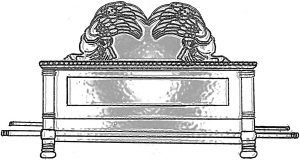Ark of the Covenant — Why Isn’t it in the New Testament?
The Ark of the Covenant was a sacred chest during the Old Testament period (Exodus 25:10-22). If you’ve seen the popular movie Raiders of the Lost Ark then you’re familiar with this chest. The “lost Ark” in that film is the Ark of the Covenant; a cinematic replica, that is.
The Ark was made of acacia wood overlaid with gold.
According to Hebrews 9:4 the Ark contained:
- The stone tablets on which the Ten Commandments were written (Deuteronomy 10:2).
- A pot of manna, the miraculous food that God provided for the Israelites in the wilderness after being rescued from slavery in Egypt (Exodus16).
- Aaron’s rod that budded (Numbers 17).
The lid of the chest was made of pure gold and dubbed the “Mercy Seat,” which will be explained in a moment. Two gold-sculptured cherubim—angels—were mounted on the Mercy Seat facing each other. And the LORD’s presence dwelt above the Mercy Seat between the cherubim (Exodus 25:22).
The Ark was housed in the innermost chamber of the Temple (and, previously, the Tabernacle) known as the Holy of Holies.
Once a year, on the Day of Atonement, the High Priest entered the Holy of Holies and sprinkled blood on the Mercy Seat for the sins of the nation of Israel. But the blood of bulls and goats could only cover their transgressions year-to-year; it could not cleanse them of their sins. This reveals one of the many reasons the New Covenant is superior to the old one: Christ didn’t offer the blood of animals on an earthly copy of the Ark, but rather offered his own blood, sprinkling it on the true Ark of the Covenant in Heaven (Hebrews 10:1-4 & 9:23-28).
This explains the name of the Mercy Seat: The spilling of innocent blood on the lid of the Ark would cover the Law of God contained in the Ark, represented by the tablets. This is important because the Law “kills” due to the fact that “the wages of sin is death” (2 Corinthians 3:6 & Romans 6:23). With the Law covered by the blood of a substitute the LORD’s mercy was able to flow to those in covenant with God, the Israelites.
The Total Sinfulness of Humanity
Interestingly, the three articles in the Ark represented the total sinfulness of the human race before the Creator:
- The Two Tablets represented humanity’s rejection of the Law of God (Exodus 32).
- The Manna represented humanity’s rejection of God’s provision (Numbers 11:4-6).
- Aaron’s Staff represented humanity’s rejection of God’s human leadership (Numbers 16-17).
Since cherubim are associated with the presence of God as guardians and servants (Ezekiel 1 & Genesis 3:24), the two sculptured cherubs on the lid of the Ark flanked the presence of the Almighty. The Mercy Seat was made of pure gold and was comparable to God’s throne on Earth during the Old Covenant since He literally dwelt above the Mercy Seat between the cherubim (Psalm 99:1). Since God is absolute righteousness and perfect justice and “the wages of sin is death,” the sinfulness of humanity—wholly represented in the Ark—incurs the LORD’s just penalty of death. This is why “the letter kills” and why all humanity is under a death sentence.
Thankfully, the blood of Christ was sprinkled on the Mercy Seat in Heaven by Christ Himself, as noted above, and so mercy flows to those who approach God through the blood of Christ. They are saved from death and obtain eternal life. As it is written:
“For God so loved the world that he gave his one and only Son, that whoever believes in him shall not perish but have eternal life.”
John 3:16
“Whoever believes in the Son has eternal life. Whoever rejects the Son will not see life. Instead, the wrath of God remains on him.”
John 3:36
The Christ Symbolism of the Ark
Just as interesting, every aspect of the Ark pointed to the Messiah, Jesus Christ, and his work:
- The acacia wood symbolized Jesus’ humanity while the gold symbolized his deity.
- The Ten Commandments inside the ark symbolized the Law of God. Christ was/is the Living Word (John 1:1-3,14) and so perfectly obeyed the Law, the written Word.
- The pot of manna spoke of Yeshua as the Bread of Life, our life-sustainer (John 6:47-51).
- Aaron’s staff that budded represented Christ’s resurrection, as the rod was dead wood that miraculously came to life; it not only budded, it blossomed and produced almonds (Numbers 17:1-8).
- The Mercy Seat also pointed to the Messiah in that Jesus’ blood was sprinkled on the heavenly Mercy Seat and, as such, believers receive mercy from the effects of the Law—death.
The Ark of the Covenant was Lost
The last time the Ark is mentioned in the Old Testament is 2 Chronicles 35:3, which was during righteous King Josiah’s reign in Judah. Unfortunately, the subsequent kings led Israel back into utter apostasy and thus the LORD allowed Babylon to sack Jerusalem and take the apostate Hebrews into exile.
No one really knows what happened to the Ark, but there are theories, including:
- Many believe it was simply destroyed when the Temple was burned (2 Kings 24:13).
- Jewish tradition suggests that it was hidden in a vault underneath the Temple Mount.
Why isn’t the Ark Mentioned in the New Testament?
There’s interestingly no mention of the earthly Ark of the Covenant in the New Testament. Why? Simply because there was no more need for the Ark; Jesus fulfilled all that it stood for, as noted above.
This fact is pictured in an amazing verse that shows events shortly after Jesus’ bodily resurrection. Mary Magdalene peaked into the tomb where Christ’s body was laid to rest and notice what she sees:
and [she] saw two angels in white, seated where Jesus’ body had been, one at the head and the other at the foot.
John 20:12
Is this not reminiscent of the Mercy Seat—two angels facing each other with the presence of the LORD between them? In other words, this is the New Testament Mercy Seat.
Why is this significant? Because the Ark was linked to the presence of God in the Old Covenant. As such, the Israelites had to go to the Temple (and, earlier, the Tabernacle) where the Ark was located in order to encounter God during Old Testament times.
In the New Testament, however, born-again believers are the temple of God and the Spirit of Christ dwells within us! (Romans 8:9).
And this explains the mystery of the gospel: “Christ IN YOU, the hope of glory” (Colossians 1:27). This doesn’t just refer to the Holy Spirit indwelling you—as awesome as that is—it refers to the fact that your spirit has been born anew of the seed of Christ and is a “new creation” “created to be like God in true righteousness” (2 Corinthians 5:17 & Ephesians 4:22-24). Chew on that mind-blowing tidbit.
View our related video…
comments powered by Disqus




